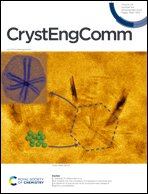Spontaneous formation of barium sulfate crystals at liquid–liquid interfaces†
Abstract
Crystallisation at or near interfaces plays an important role in many environmental, biological and industrial processes. In this study, crystallisation was investigated at the interface between two immiscible solutions undergoing spontaneous transfer of ions. Using barium sulfate (BaSO4) as a model system, crystallisation at the aqueous–organic interface was investigated in cases where barium ions were placed in either the aqueous phase or the organic phase, and the co-reactant sulfate in the adjoining phase, respectively. Formation of precipitated solids was found in both cases, resulting from the spontaneous transfer of ions from the organic phase to the aqueous phase where precipitation occurred. Characterisation of precipitated solids was performed by Raman spectroscopy, scanning electron microscopy (SEM), energy dispersive X-ray spectroscopy (EDS) and transmission electron microscopy (TEM), confirming the crystallisation of BaSO4 at or close to the interface. The influence of a neutral ionophore in the organic phase on spontaneous formation of BaSO4 was also studied, demonstrating the capability to impede the transfer of ions and hence the precipitation process. Overall, these results provide a proof-of-principle demonstration of the ability to form ionic crystalline materials by exploiting ion transfer processes at the interface between immiscible liquids.



 Please wait while we load your content...
Please wait while we load your content...